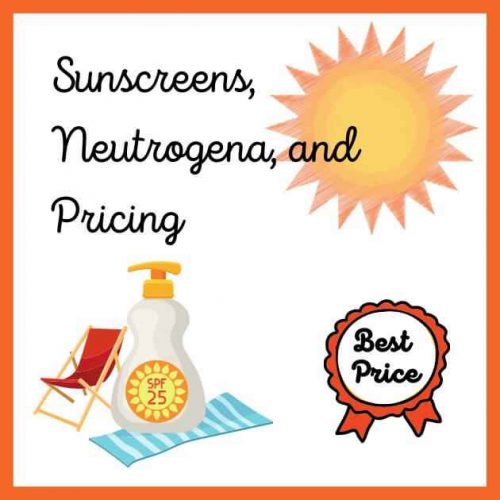Recently, a cosmetic scientist with a proper PhD and all, wrote a post on the different types of sunscreen formats – sunscreen sticks, sprays, lotions etc. It was a useful post. Had I not read it, I wouldn’t have appreciated that folks tend to not use enough sunscreen around their eyes. But some of it was self-explanatory such as avoid inhaling sunscreen while using a spray can.
As the post was sponsored by Neutrogena, she didn’t touch on the pricing of products.
I, being an independent blogger can talk about pricing till the cows come home. This post is just about pricing because statistically, lower income groups spend less on sunscreen than higher income groups. Secondly, there is a pandemic out there and apart from Jeff Bezos absolutely everyone is tightening their purse strings.
Neutrogena’s data
As Neutrogena was the sponsor of the post, it would be sacriliege to use anyone else’s data. We can all agree on a few things: An SPF 50 in a stick, spray or face/body lotion should offer the same level of protection.
Does a sunscreen stick almost cost the same as a sunscreen lotion?
If I search by SPF value – so “SPF 50” – on Neutrongena’s American website, the following results are returned:

I have literally lifted this photo from Neutrogena’s website and simply put it in a format that facilitates easier comparison. It pretty much looks like there are a couple of dollars difference for adult sunscreens and a bit more for children’s sunscreen. The most expensive products are Zinc sunscreen sticks (including a kid option) and the cheapest products are priced at US$ 10.99.
Price/oz comparison
The above image is NOT a fair comparison: that would be to compare price/oz. Miraculously, the above photo now looks like this:

All of a sudden the body products are much cheaper, especially sunscreen sprays and body lotions (Beach Defense SPF 50)
Price/oz for products used on the face
The difference in price/oz is more stark when I take out sprays and body lotions.

So the cheapest sunscreen is US$ 4.33/oz Sheer Zinc in a lotion format. However, the same product and SPF value is more expensive in a stick format (US$ 11.66). Also, note that a kid’s Sheer Zinc sunscreen stick at $10.66 is not much cheaper.
Closing remarks
Brands do not make it easy to compare prices.
It used to be much easier to filter for (e.g.) an SPF 50 sunscreen on Neutrogena’s website. Now you have to filter by format type – sticks, sprays and lotions. Therefore, Neutrogena (like other brands) is counting on you to NOT compare sunscreen prices based on price/oz.
My solution is to look at the websites of American pharmacies where price/oz data is readily available. Alternatively, it is worth looking for a pharmacy option. For example, CVS pharmacy’s Sheer Zinc formulation is almost identical in formulation to its Neutrogena counterpart.
The worst thing you can do is to stop using sunscreen, especially for kids, as sun damage is cumulative. Over 75% of sun-exposure occurs before the age of 18, so sun protection is vital for children, especially Caucasians.
Also, there is no reason why the adult versions of the mineral sunscreens from these brands should not be used on kids, if they are bog-standard Zinc Oxide formulations. (Just keep a watch out for nasty chemicals: parabens, BHT and Oxybenzone).
All these formulas have nearly identical ingredient lists but at different price points. They all have 21.6% Zinc Oxide in their formulation.
The products are:

I’ve compared their prices to Neutrogena’s SheerZinc Face SPF 50 and on a per unit basis: Neutrogena SheerZinc Dry-Touch Face sunscreen SPF 50 (Most expensive), Aveeno Positively Mineral Face sunscreen SPF 50 (34% cheaper), CVS Health Zinc Face Sheer Lotion SPF 50 (61% cheaper), CVS Health Zinc Sheer Lotion SPF 50 (68% cheaper).
When in doubt, please ask me. You can drop me a line at email@happyskindays.com or leave a comment about sunscreen products that you are unsure of OR even questions about pricing. I like maths and research so both are fun for me to answer!
